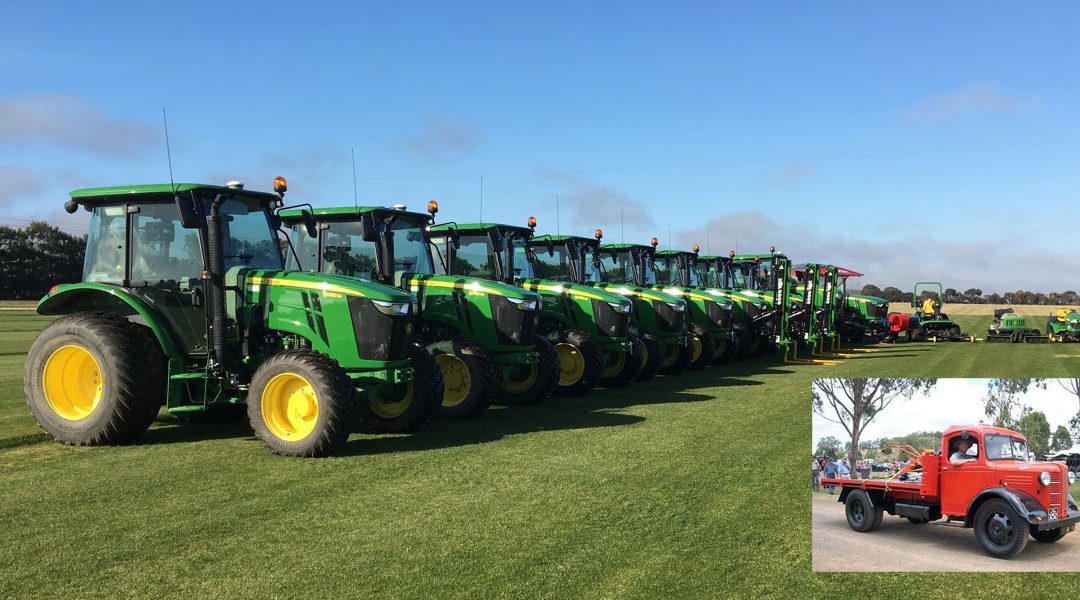South Australian growers Scott and Ingrid Bormann shared their story at September’s TurfBreed Conference.
It was an inspirational account highlighting the Bormanns’ persistence and their never-say-die attitude: their conviction that no hurdle is too big, and no new trial too daunting. It also proved that it is possible to operate a sustainable business during both good and bad times.
The story following is an edited version of Scott’s presentation …
“Bormann Turf started in 1970 when my parents inherited a bankrupt 100-acre property from my grandfather, an unsuccessful farmer, near Woodside, in the Adelaide Hills.
My father was, and still is, the determined type. He taught me the value of a good work ethic and proved that “effort and determination equals rewards”.
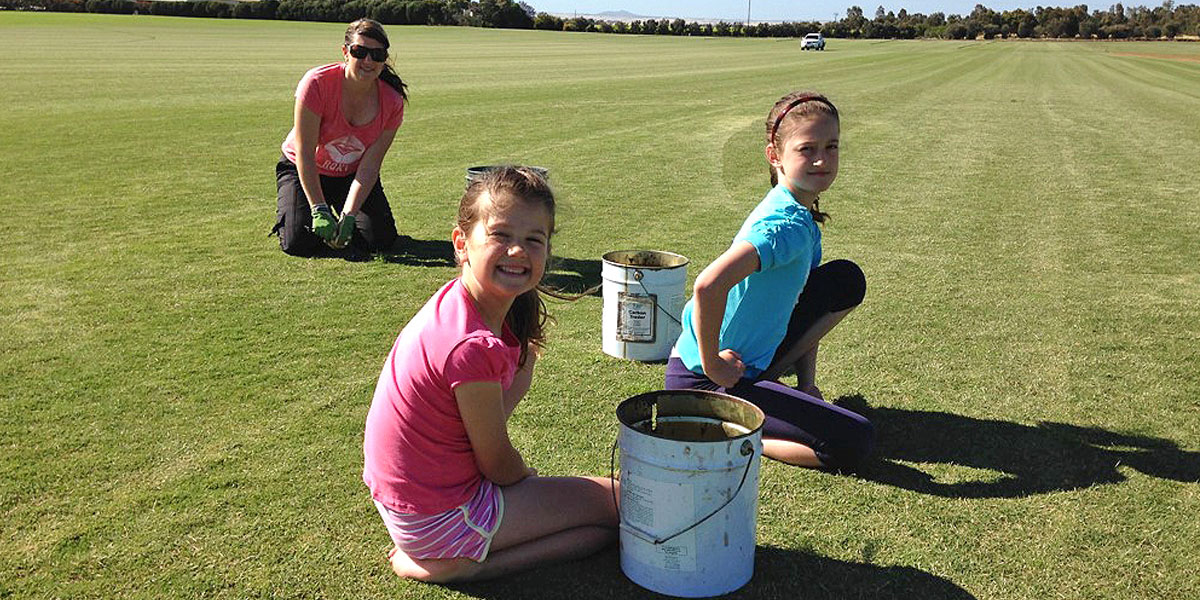
Above: The Bormann family hard at work.
The turf journey begins…
In 1977, my landscaper Uncle needed instant turf for some of his projects. He tried to grow cool season perennial rye grass on his small acreage at Mt Barker (not far from Woodside).
My Dad watched as he went about it the hard way, and eventually offered to try growing turf on our farm. Bormann Turf started in 1978 and we are celebrating our milestone 40th birthday this year.
At that time there were no turf conferences, turf magazines or internet for us to learn from. It was all trial-and-error.
The first two-acre patch was a cool season mix of fine fescue, rye grass and blue grass which was later named ‘Sun and Shade’. This was mowed weekly by five sheep, who also assisted in the fertilizing program. Processes and equipment rapidly changed after we realized sheep were not a great alternative to a mower.
Because of limited funds, early machinery was basic. We used a small walk-behind sod cutter, which had no chop-off blade, so a knife welded to the end of a piece of pipe was used as a measuring stick. This then manually chopped through each sod, with the sods folded and hand-loaded onto the back of our old Austin truck. Our biggest day in that first year was 300 square metres (m2).
Fast forward 30 plus years
More efficient machinery and new processes led to a new daily record harvest of 12,306m2 in 2013 – the equivalent of almost one football field and a 4102 per cent increase on 34 years earlier.
From 1990 to 1993, we relocated the whole business from the Adelaide Hills to Langhorne Creek on the Fleurieu Peninsula, one-hour south-east of Adelaide’s CBD.
We bought neighbouring farms and expanded our production area from 48ha at Woodside to more than 100ha and converted our solid set irrigation to central pivot.
This big move allowed us to achieve a 12-month sales cycle, which was not possible during the cold wet winters at Woodside.
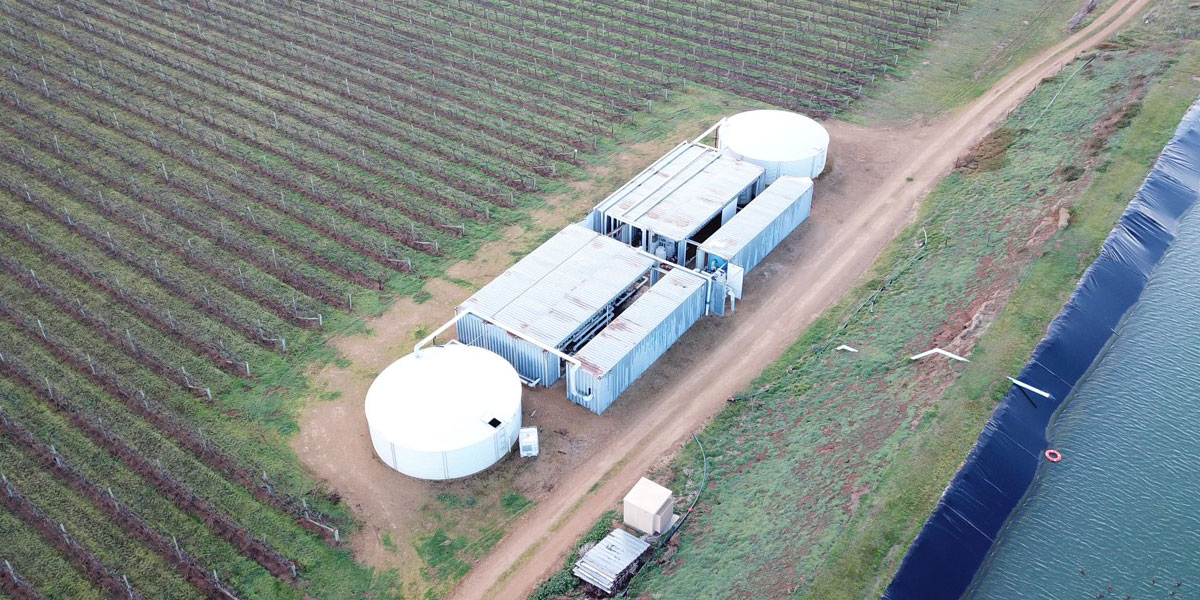
Above: Desal plant constructed from 8 x 40ft shipping containers.
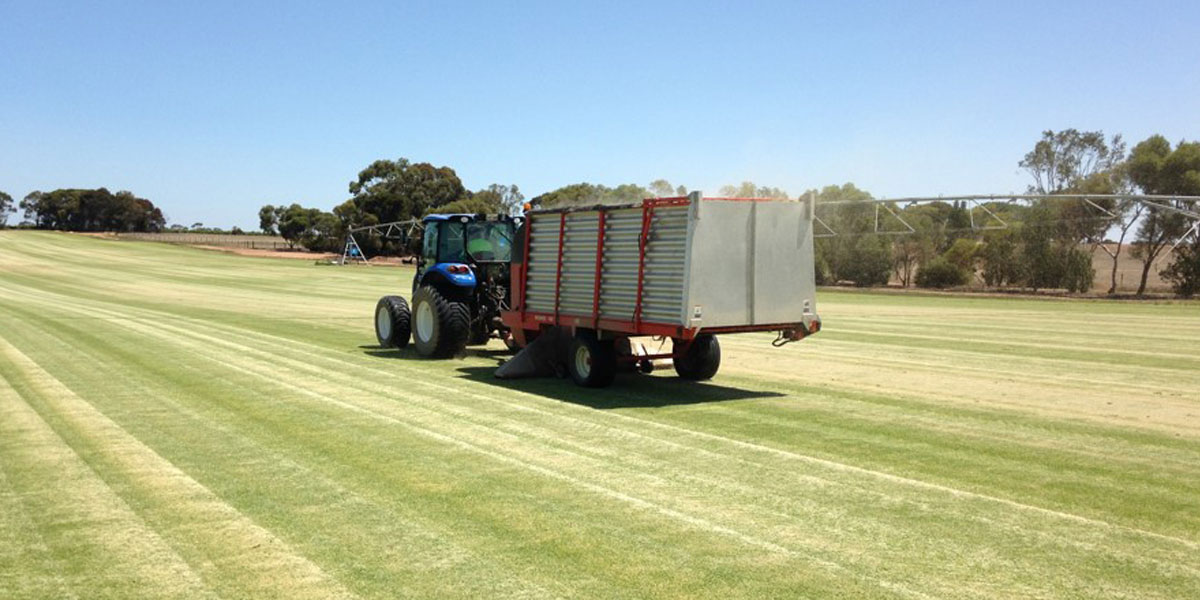
Above: Vacuuming Turf
Water – sourcing on a big scale
Water security has always been an issue. The purchase of the new properties at Langhorne Creek hinged on access to a new and greater water supply.
Coupled with a water licence to buy permanent water, our annual 700 megalitre (ML) allocation was initially sourced from Lake Alexandrina, at the end of the Murray River before it flows through to the sea.
Together with a neighbouring potato farm and vineyard, we invested in a joint pipeline to pump water 10km through a 15-inch diameter pipe into a main dam. We then re-pumped the water into our individual dams, or direct into our irrigation equipment.
This concept worked well for the first 15 years. Then a severe drought took hold. Pre-drought salinity was about 500 parts per million (ppm) and during the 2007/2008 irrigation year when the drought was at its worst, the lake level became critically low and the salinity rose to 4000ppm. As well as poor water quality, our licence was cut to just 50 per cent of our annual entitlement and heavy water restrictions were imposed on the end users – home owners who might be trying to establish a new lawn or water their garden to keep it alive.
The outcome was a 50 per cent downturn in business which had some big implications for employee retention and crop and soil health.
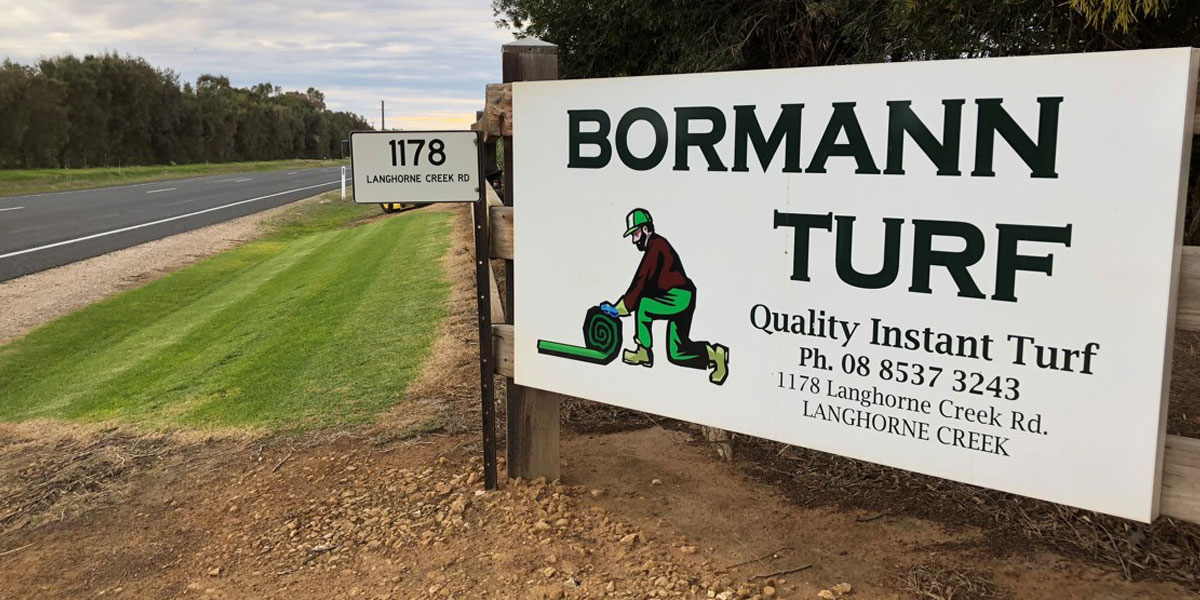
Fighting against all odds
We weren’t about to sit on our hands and do nothing, so we teamed up with two of our vineyard neighbours and bought a $2 million reverse osmosis desalination system from Biosystems in Indonesia.
The partly pre-built unit was delivered to us in eight 40-foot shipping containers that bolted together to form a plant that could produce 3ML of good quality water (about 500ppm salinity) per day.
Our half-share was 1.5ML/day, which was just enough for our needs, but the cost of electricity was $900/day.
A month later the South Australian Government announced construction of a community pipeline to service 80 irrigators. It would go straight past our property and supply river water of better quality than our desalinated water and at a lower cost.
“Would we have done it again if presented with the same chain of events? Of course we would.”
What does one do? We chose to buy shares in the new community line and decommissioned the desalination system after only four months of use. We’re still trying to sell the plant – now valued at less than $100,000, which is a pretty hard pill to swallow.
Would we have done it again if presented with the same chain of events? Of course we would. We could never sit back and watch our business dissolve.
Since then conditions have returned to normal and we have experienced some good seasons. We are far more aware now of early signs of trouble and wiser about how to best manage soil health and turf quality.
Creating a sustainable team
Our workforce is 10 full-time permanent employees and two or three casual employees for the six months of peak operation time. We aim to keep every staff member employed, reducing numbers as a last resort.
Most of our employees are up to 10-15 years of service and are a big part of who we are as a company – a proud South Australian family business.
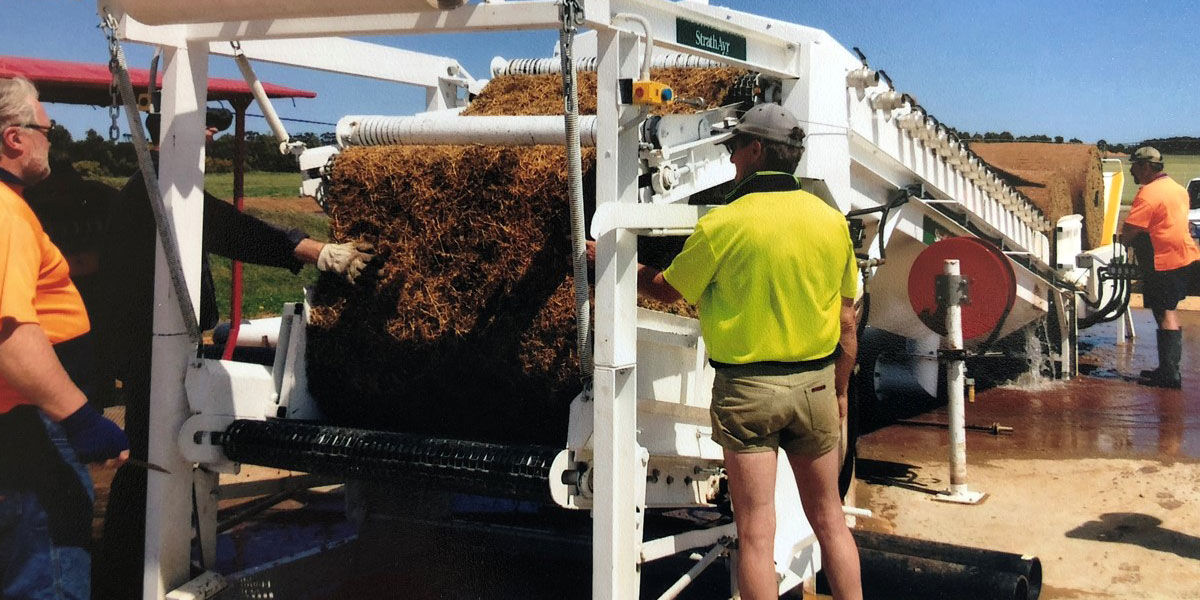
Above: 5000m2 per day Maxi sod washer.
Below: 300m2 per day washed soda sandwich.

Keeping it simple
Our business philosophy is to keep it simple. We are often using the phrase ‘Sorry, we don’t offer that service’. We are a wholesale turf farm that only produces high quality turf and washed sod. We don’t have a business brand, market our product, offer turf installation, have delivery trucks or offer a delivery service.
We focus solely on growing high-quality turf for the Australian market. We let other specialists in their fields do the other bits like marketing and transport.
This business model also keeps our administration to a minimum, so we can pass those savings on to our seven wholesale account customers. These customers are valuable to us and, even though several are direct competitors to each other, there is enough room in the retail and commercial market for them all to co-exist.
Our target market is a 50/50 split between Domestic and Commercial. We have been privileged to supply commercial quantities of turf to the Adelaide Oval, Canberra Stadium, Etihad Stadium and a good number of the AFL training grounds throughout Victoria. These high-profile jobs wouldn’t have been possible without the support and loyalty of our agents and retailers.
A mindset switch to sod washing
Growing interest in washed sod encouraged us to custom-design a washer, called the sod sandwich, which produced 300m2 per day. Demand increased and we improved the design to achieve 1000m2/day.
Before we knew it, clients were wanting 15,000m2 sports fields washed in no longer than a week.
We bought a full-scale commercial washer and – because of our nice sandy loam soils – we are now able to wash volumes of 800m2/hour or 5000m2/day.
A look into varieties
We deliberately grow only four varieties and have separate dedicated mowers and harvesters for each.
This helps keep our strains of turf pure and our daily operation as efficient as possible, so we don’t need to clean equipment up to 10 times a day when we switch between fields to harvest multiple varieties.
It also enables us to run a live update ordering system for our seven agents. Once orders close at 12pm, we have two hours to have all the turf ready for transport companies to collect.
Kenda a proven market success
Variety choice is an essential part of our business success and thanks to companies like TurfBreed, we can not just follow market trends but also offer the latest and greatest variety for our particular market.
One of the varieties that has been a success is Kenda Kikuyu.
We were very anti-Kikuyu for the first 20 years, viewing it as a major pest or uncontrollable weed amongst our other cool season varieties. But as market demand for Kikuyu increased, we looked for a new and improved version of the Male Sterile strain.
After an extensive 12-month trial of Kenda, we obtained a TurfBreed licence to grow a commercial 3ha field to supply our South Australian domestic market. The retailer already sold the Male Sterile strain of Kikuyu, sourced from another supplier, but was able to educate clients about Kenda’s point-of-difference: its greener, lusher appearance for most of the year.
In the past five years, our Kenda production area has grown to 15ha, putting us in a good position to confidently supply our intended market for 12 months of the year.
“Kenda’s point-of-difference: its greener, lusher appearance for most of the year.”
The Kenda experience has been a learning time for us regarding different maintenance and management strategies. However, all the challenges have had positive outcomes. We especially like the short period of regeneration from harvest to harvest and we experience an overall four to six-week reduction in maturity time. This aids in the more efficient use of inputs such as fertilizer and water, and mowing and general production space.
Keys to our success with growing Kenda are:
- Increasing mowing frequency to four days through the summer months.
- Using lighter and more frequent fertilizer applications to help control thatch build-up.
In the peak of the summer months, we occasionally lightly dethatch the Kenda, so irrigation water and fertigated liquid nutrients can get down to the crown of the plant. This process also helps more light reach the crown of the plant and air circulates to prevent fungus and disease. The overall density and colour of Kenda is very favourable compared to its competitors and it has earned a respected place in our line-up of varieties.
Looking ahead
From a grower’s perspective, TurfBreed is an important partner in our future success in this competitive industry. We really appreciate the Company’s efforts, not just in promoting a brand or product but the help and support given to us, as a grower, and to the wider community making decisions about turf.
A bit of care goes a long way. “ TB
If you are want to talk to Scott about his story he can be contacted via T: (08) 8537 3243 or E: scottbormann@bormannturf.com.au

